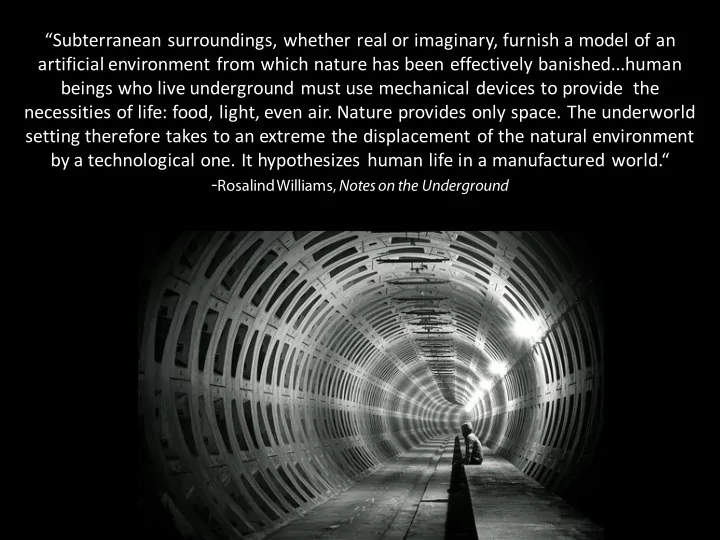

“Subterranean surroundings, whether real or imaginary, furnish a model of an artificial environment from which nature has been effectively banished...human beings who live underground must use mechanical devices to provide the necessities of life: food, light, even air. Nature provides only space. The underworld setting therefore takes to an extreme the displacement of the natural environment by a technological one. It hypothesizes human life in a manufactured world.“ - Rosalind Williams, Notes on the Underground
• Subterranean history of the nineteenth century provides a striking disparity between actuality and imagination. • In actuality, excavation = progress (advancement of knowledge and the conquest of external nature) • In “architectural fiction”, projects tend to find security from natural or social peril • They foresee our enormous investment in subterranean projects motivated primarily by our desire to evade ecological and military disasters Oscar Newman’s 2 nd NYC Paris Metro Station Repurposed Missile Silo
MATSYS Architecture as Narrative • Fictional world where water is extremely scarce (Dune, 1965) • Ties infrastructure (the subterranean “sietch”), used for the collection & storage of water to a high density underground community • ”These structures constitute a new neighborhood typology that mediates between the subterranean urban network and the surface level activities of water harvesting, energy generation, and urban agriculture and aquaculture”
SITE: E: future Nevada Desert METHOD OD: fictional narrative/literature created to discuss real possibilities PROGR OGRAM: high density subterranean community • In desert regions, water is actually • Housing & commercial structures held in underground basins • Infrastructure – water storage/collection • Protection from war “The reason for constructing an underground environment in the first place is to find security from nature's risks and limits. Fear of disaster impels human beings to seek more control over their environment”
Edouard Utudjian • underground shelter vs underground urbanism. The former he considers an escape, though sensible in extreme climates. The latter he considers indispensable, believing that modern cities must extend in three dimensions to be livable. • Approached urban planning by seeing the underground a comprehensive part of the city (four principal resources: space, water, geothermal energy and geomaterials) • Advocated putting the “less glamorous” aspects of civilization underground • proposed citywide systems of underground infrastructure: “elaborate grids of trenches, 1000 feet wide and 200 feet deep would hold utility and distribution networks, central heating and cooling factories, recycling and waste treatment plants, and factories. • Allow the surface would be liberated for parks, housing, schools, and other less utilitarian functions – Underground as functional counterpoint to the space above
Lebbeus Woods • Fictional project and screenplay written in 1989 (year Berlin wall fell) • Underground Berlin, “is a city beneath a city. It is organized as a secret community of resistance to the occupying political powers above and follows existing U-Bahn subway lines.” • implies that there was not just an East Berlin and a West Berlin but an Upper and a Lower fragmentation of the metropolis • Designing in the “3 rd dimension” • ” the city is divided above ground but unified below ” • Here the underground is viewed as a utilitarian, utopian landscape that exists beneath a politically divided society above ground
On Beauty, Aurora, Nature Edmond Burke suggests that feelings of sublimity might be aroused not only by external nature but also the "artificial infinite", a nonorganic visual object of great dimensions. While not literally underground, they convey an overwhelming sense of enclosure. They are architectural approximations of a subterranean environment. Vienna’s S-Bahn Station Piranisi’s prisons
Earthscraper (BNKR) Low-Line (James Ramsey) "With the rise of urbanization, cities will soon face the issue of accommodating an influx of citizens. This will result in increased housing developments, and for land- scarce urban centers, increase in high-rises. After all, if a city cannot or will not expand outward due to any variety of reasons, the only way it can go is up… Perhaps instead of focusing on city expansion, we should continue to focus on the spaces that we have already used and work not only in the upwards direction, but possibly the downwards one as well.” -Liam Young
Recommend
More recommend